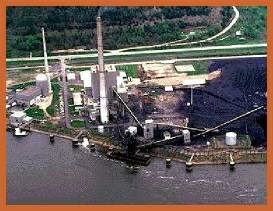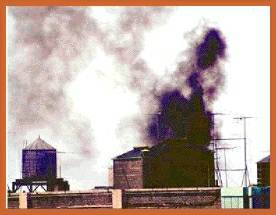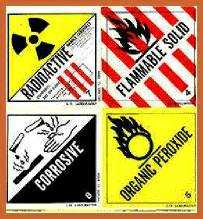|
PinkMonkey Online Study Guide-World History
20.1 Types of Pollution
A pollutant is any solid, liquid or gaseous substance
present in such a concentration, so as to be injurious to the
environment. Some of the common pollutants in developed as well
as developing countries are : gaseous pollutants such as oxides
of nitrogen, fluoride compounds, metals like mercury and lead, complex
organic pollutants like benzene, petrochemical oxidants like ethylene,
deposited matter like smoke and soot, solid waste, poisons like
herbicides and fungicides, fertilizers, radioactive waste, noise
and heat.
From the point of view of the ecosystem, pollutants
may be classified as nondegradable pollutants like aluminum
cans and DDT which do not degrade or degrade only very slowly in
the environment, and biodegradable pollutants like domestic
sewage which gets decomposed rapidly. Pollution may also occur naturally
in the environment.
Adverse effects are noticed on plants since agriculture
and horticulture are both affected by pollution. Air pollutants
produce eye and respiratory irritation in animals and also in humans.
Water pollutants can endanger aquatic life thus millions of fish
are reported killed by municipal and industrial wastes. Sewage,
toxic chemicals, and diseases causing germs can also make water
unfit for farm animals. Thermal pollution, namely excessive heating
of water in rivers or lakes can kill fish. Many diseases are water
borne. Water pollutants like suspended particles can also adversely
affect industrial equipment.
Air pollution is regarded as the most dangerous
and common kind of environment pollution in recent times. The Bhopal
Gas Tragedy in 1984 is regarded as the worst industrial accident,
related to air pollution. Around two lakh Bhopal residents were
affected by the leak of poisonous MIC gas from the Union Carbide
Pesticide plant in Bhopal (India).
20.1a Air Pollution
(i) The Green House Effect
Large amounts of carbon dioxide are introduced
in the atmosphere from fossil fuel burning, furnaces, and respiration
of animals. Some of it is absorbed by water or is utilized by
plant life. Much of the carbon dioxide is confined to the troposphere.
The heated earth tries to reradiate the energy it has absorbed
from the heat of the sun. However much of this cannot pass through
the carbon dioxide layer into outer space. Thus the earth’s atmosphere
heats up. This is known as the Green House Effect.

Exhibit 20.1
The Green House Effect
Some of the major causes of the Green House effect
are the cutting down of forests. As more and more trees are being
cut down there are fewer trees left to absorb the harmful Carbon
Dioxide from the atmosphere. Secondly, the smoke given out by
the factories is also an important cause and finally the fumes
from cars and trucks, also contributes to the Green House effect.
An increased heating of the earth would cause a rise in ocean
levels, owing to the melting of ice caps and the receding of glaciers.
Low-lying coastal cities like Bangkok and Venice are in a danger
of getting flooded. Some of the small islands in the Caribbean
might even vanish. On the other hand, deserts might spread further
than they are now.
(ii) Ozone
Ozone protects us from
harmful solar radiation. Any large-scale depletion of ozone content
can exert catastrophic influence on biotic systems. However, during
the past few years, it is evident that the ozone concentration
of the earth’s atmosphere is decreasing largely due to the increasing
use of CFMs or chloro fluoromethanes, that are used as propellants
in pressurized aerosol cans, for example. Many ecologists also
feel that the jet engines of supersonic aircrafts flying at high
altitudes release nitrogen oxide, which endangers the protective
ozone layer of the stratosphere. If efforts are not made to slow
ozone depleting air pollutants, temperatures around the world
may rise, endangering the human species
besides other animals.

Exhibit 20.2
The ill-effects of Air Pollution are beginning to
show
20.1b Water Pollution
The major sources of water pollution may be classified
as domestic, industrial, agricultural and shipping
wastewaters.
Domestic wastewater may arise from homes and commercial
establishments. Many rivers and fresh-water streams are seriously
polluted by industrial wastes or affluent. The chemicals of industrial
wastes are highly toxic to animals. A steep rise in fish mortality
was reported in the river Sone, in Bihar (India) owing to the chlorine
content chemical wastes discharged by factories near the site. In
Japan, in the 1950’s illness and even death occurred among the fishermen
who consumed fish, contaminated with methyl mercury from Japanese
coastal industries.
One of the major sources of water pollution is
Acid Rain. This is a term used to describe rain or snow that has
been polluted by Nitric and Sulphuric acid. Acid rain is formed
when there is a combination or a reaction of the water vapor in
the air with the gas emitted by vehicles, factories and other sources.
These acidic gases and particles can even reach the Earth when there
is no rain. Scientists use the term Acid Deposition to refer to
wet and dry Acid Pollution that reaches the Earth. Scientists believe
that Acid Rain is responsible for the destruction of trees, crops,
soil and even buildings and statues. The phenomenon of Acid rain
is common in Eastern North America and Central Europe.
One way of reducing the Acid pollutants is by removing
Sulphur and Nitrogen compounds from the air. Devices have been developed
to remove these compounds from the emissions of factories. In some
of the areas, lime is added to the lakes and rivers, in order to
neutralize the acidity. This is a temporary solution and can have
harmful side effects.
Rainwater, running through farms, carries pesticides
and chemical fertilizers and dumps them into the rivers and lakes.
Farm animal wastes also enter waterways and pollute the water.
Shipping water pollutants include both human sewage
and other wastes, such as oil. Oil pollution is of concern owing
to the sensational major spills from ships and offshore drilling
rigs, and also from small spills and cleaning operations.
Several waterborne infectious diseases are directly
related to polluted water. The aquatic water chain concentrates
several toxic substances in fish eaten by seals, certain birds or
by people. Beaches are also closed when solid waste is washed up,
or because of oil spills.
Oil pollution from accidents involving large tankers
and offshore drilling rigs has attracted international attention.
For example the Torrey Canyon carrying over 100,000 metric tons
of Kuwaiti oil for the Union Oil Company ran aground off Cornwall,
England on March 18, 1967. It released most of its cargo in the
water, causing large-scale destruction of sea birds, not to mention
detrimental effects on other ocean life, such as plankton. Several
dozen large tanker accidents are reported every year. Efforts are
made to contain the oil spills such as surrounding the oil slick
with a mechanical barrier, or collecting it with suction pumps.
However, these methods are slow and expensive.
Marine pollution occurs as sewage, garbage, pesticides,
and discharge of oil and petroleum products. Solid wastes like mercury,
which may be dumped into the rivers, ultimately goes into the sea.
The large amount of plastic bags dumped into the oceans has threatened
marine life. Ingested by sea birds, it causes gastro-intestinal
diseases and ulcers since plastic contains PCB, a chemical known
to cause eggshell thinning and tissue damage.
20.1c Radiation Pollution
The environmental problems of the Nuclear Age are
concerned with radioactive fallout, both local as well as
global and the consequent threat of environmental pollution.
Radioactive fallout means the deposition of air-borne
radioactive contamination on the earth. Radioactive substances can
enter the body through inhalation, through contaminated food and
drinks, and through wounds and abrasions on the skin. When people
are exposed to radiation there is bodily damage to them as well
as impairment of the health of even their descendants. Apart from
fallout, radiation sickness may be caused by x-ray machines.

Exhibit 20.3
Pollution results from radiation as well; hence warning labels are
attached.
During World War II, the U.S. dropped the first
atomic bombs on the Japanese cities of Hiroshima and Nagasaki injuring
and killing thousands of people. When a radioactive substance gets
deposited in the body, it causes delayed effects, which may include
skin cancer, leukemia and stunted growth.

Exhibit 20.4
The Chernobyl Disaster had gruesome aftereffects
The Chernobyl Explosion in 1986 in Soviet Russia
destroyed every living thing in the vicinity. Therefore it demonstrated
the hazards inherent even in the peaceful uses of nuclear energy.
[next page]
|